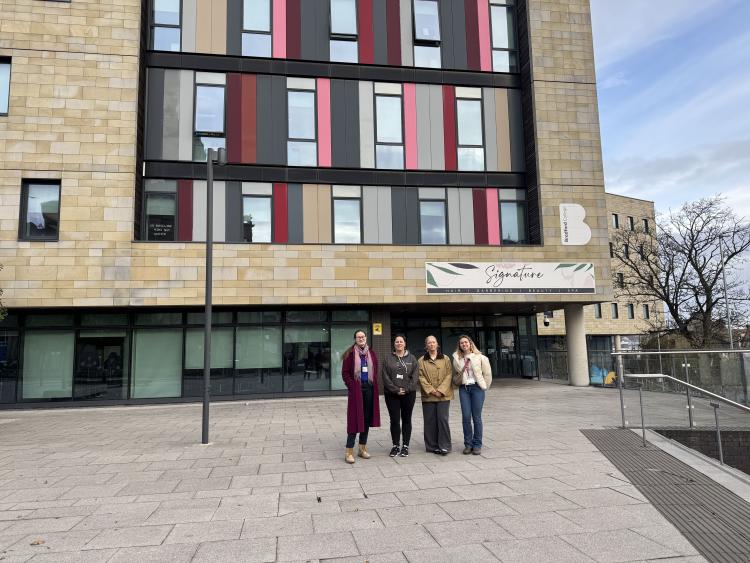Heat network plan to create energy efficiencies at Bradford College
City buildings to benefit from decarbonisation plan
An innovative £3m project to connect city centre college buildings together through the Bradford Energy Network looks set to future proof the sites for the next generation.
The scheme, spearheaded by Bradford College and partly funded by the Public Sector Decarbonisation Scheme, will connect the David Hockney Building and Advanced Technology Centre to the network by March 2026.
It means that the city centre buildings, separated by a short distance, can be heated by the same source, thanks to the Bradford Energy Network and a series of underground pipes.
The Bradford Energy Network includes around six miles of insulated underground pipework able to supply heat to major buildings across the city. 1Energy has secured investment to deliver the Bradford Energy Network to which local buildings will connect. These buildings will include those occupied by the University of Bradford and Bradford College.
Our Salix team visited Bradford College to find out more about how the operation will run before works begin in the new year.

From left: Anna Kuratnikova from Salix, Pam Sheldon, head of projects at Bradford College, Molly Evanson and Jessica Ferris from Salix.
Photo credit: Salix Finance
Our first stop was the David Hockney Building which is a college site where we were shown a large open atrium that spans five floors with the classrooms surrounding this space.
Client support officer Anna Kuratnikova said: “This is a fascinating area for development and once the pipework is installed it means it could be available to a series of sites and as a whole city can become more energy efficient.
“The plan not only brings a range of partners together, but it has created a vision for how a large city will use energy and ultimately become more energy efficient.”
During the visit we were able to understand the scale of pipework. The pipe that spurs off from the main heat network to connect to the college is about 50-75m long and will connect to the college in a small plantroom in the corner of the building via a plate heat exchanger.
This is a fascinating area for development and once the pipework is installed it means it could be available to a series of sites and as a whole city can become more energy efficient.
The plan not only brings a range of partners together, but it has created a vision for how a large city will use energy and ultimately become more energy efficient.
We were able to discuss and visualise the route the heat network pipes will take when we visited the plantroom where the heat network infrastructure will connect.
It is anticipated that traditionally heated buildings will benefit from 75% reduction in CO2 per kWh of energy used when connecting to the Bradford District Heating Network.
Bradford College was awarded £2,656,876 under Phase 3c of the Public Sector Decarbonisation Scheme. As well as connecting to the heat network, Public Sector Decarbonisation Scheme funding will also be used to pay for improvements to hot water distribution systems, pipework insulation, and emitter and substation upgrades.
During our visit we met head of projects at Bradford College Pamela Sheldon who explained how the project will work.
She said: “Joining the Bradford Energy Network is another significant milestone in Bradford College’s sustainability strategy. As a large college, we are committed to reducing our carbon footprint and this funding will allow us to completely rethink how we use our energy.
“It’s vital that we achieve long-lasting outcomes for our region and students, so we are delighted to be at the forefront of this work.”
The college, which has also secured funding from other sources, has a range of other energy efficiency works planned. This includes upgrading the fabric of the buildings for optimum thermal performance, as well as looking at lighting.
Creating a vision for future generations
Nearly 3,500 staff and students, based at the David Hockney Building and Advanced Technology Centre, are set to benefit from the transition to renewable energy.
A heat network means the network can provide a locally generated, sustainable alternative to heat produced by fossil-fuel gas boilers. By replacing gas boilers with heat network connections reductions can be made to the emissions of individual buildings.
Salix programme co-ordinator Ned Jordan said the Bradford tour was a perfect opportunity to discuss the college’s vision for the future.
He said: “Works for this phase of Bradford’s net zero journey will begin in the new year and the college is committed to this agenda.
“Ultimately it is about future proofing the site and setting it up for the generations to come. Our team looks forward to visiting again in 2025 and 2026 to see what has been achieved.”
Thank you to Bradford College for playing host to our team and sharing your vision for the future.



